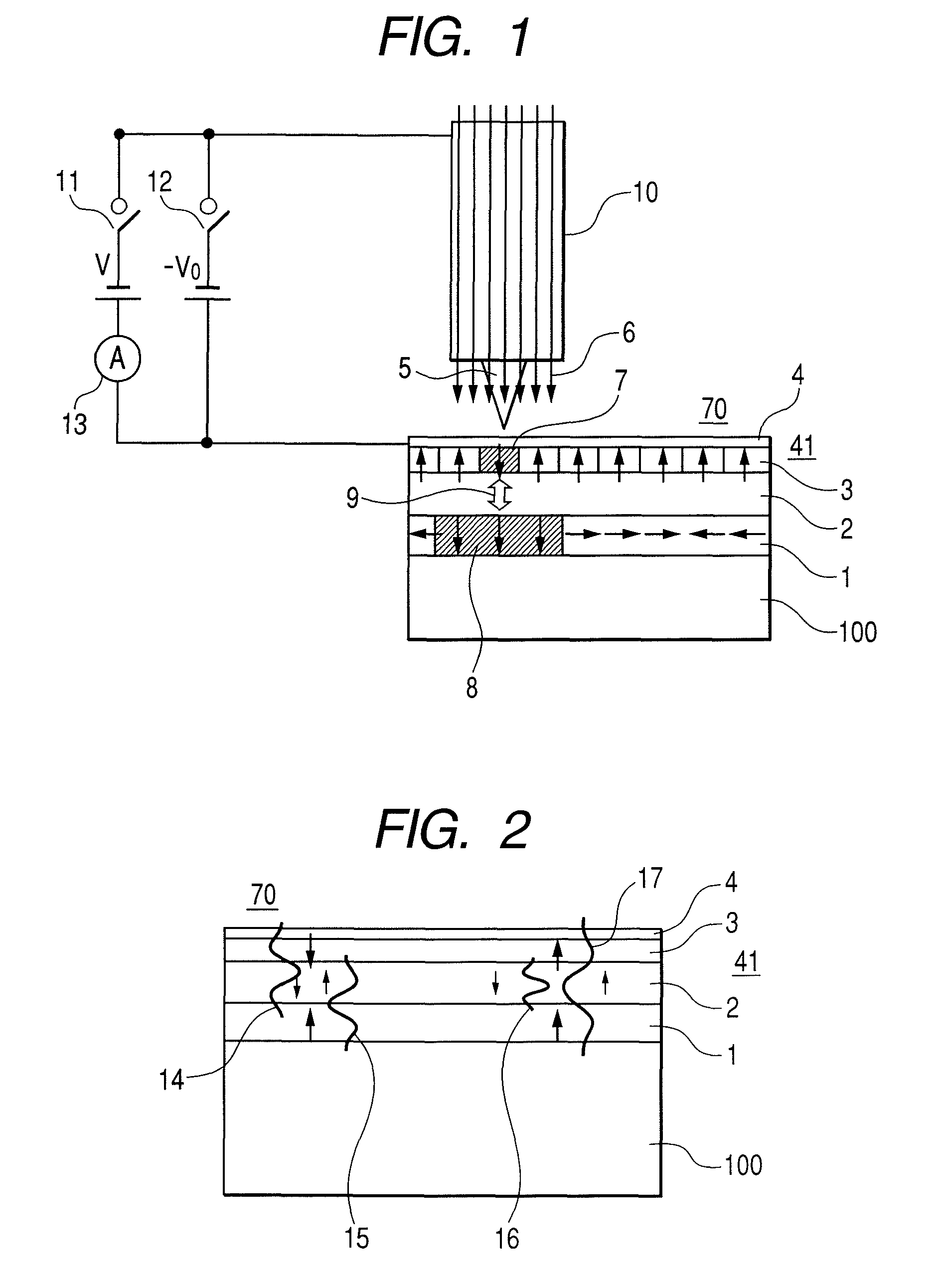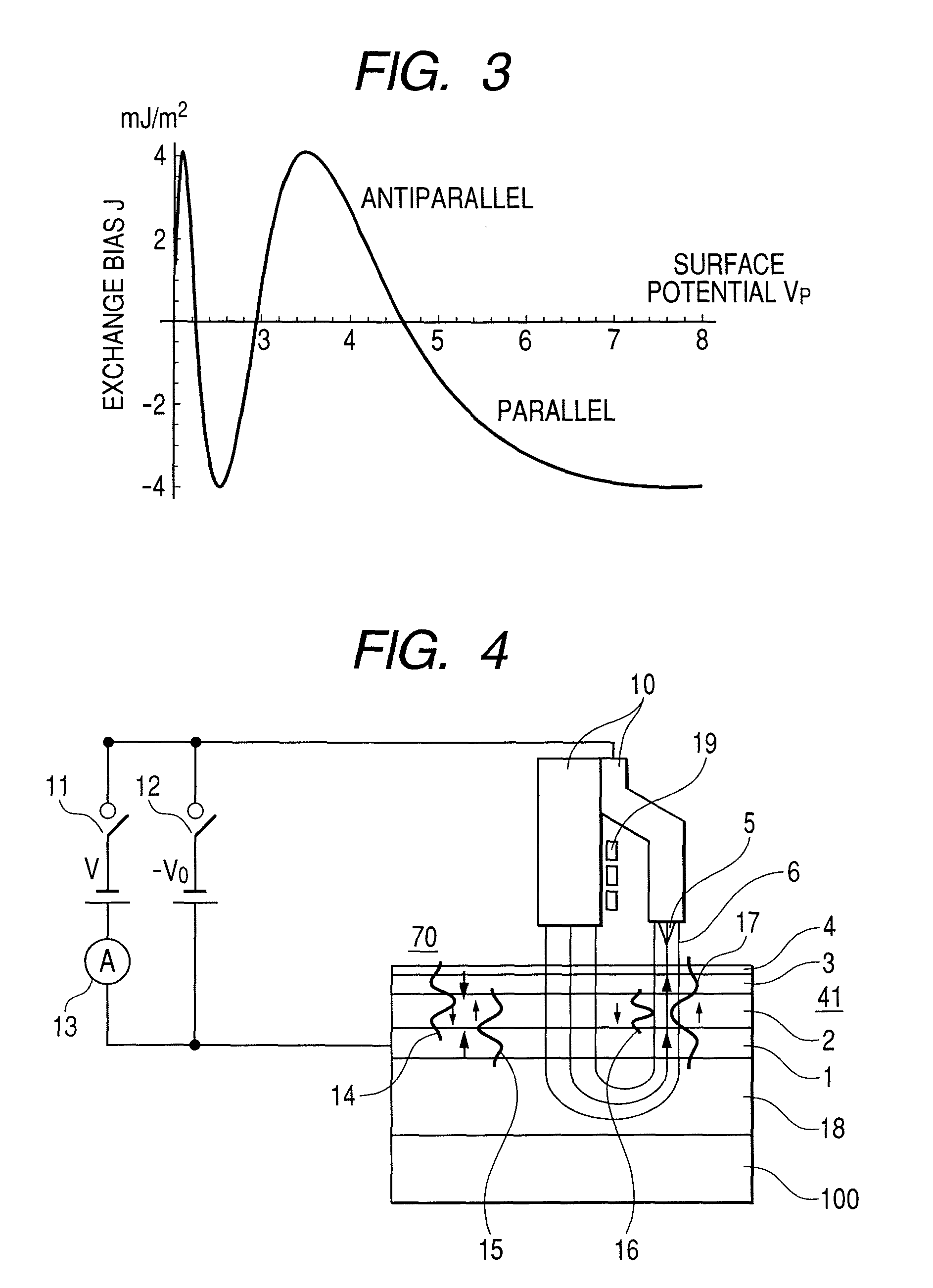Electric field applying magnetic recording method and magnetic recording system
a magnetic recording and magnetic recording technology, applied in special recording techniques, instruments, metal sheet core heads, etc., can solve the problems of difficult voltage application in non-wiring ultra-high density recording media such as hard disk drives, unstable control, and difficult formation of such layers
- Summary
- Abstract
- Description
- Claims
- Application Information
AI Technical Summary
Benefits of technology
Problems solved by technology
Method used
Image
Examples
first embodiment
[0048]Hereunder, a first embodiment of the present invention will be described with reference to FIGS. 1 through 3. FIG. 1 shows a first embodiment of the present invention, which is a concept diagram for showing configurations of a magnetic recording medium 70, as well as a metal probe 5 and a magnetic pole 10 provided so as to face the medium 70. The magnetic recording medium 70 consists of a substrate 100 and a multilayer film 41 formed on the substrate by stacking a first ferromagnetic layer (low coercivity) 1, a nonmagnetic layer 2, a second ferromagnetic layer (high coercivity) 3, and a protection layer 4 sequentially.
[0049]It is assumed here that the highly coercive ferromagnetic layer 3 and the lowly coercive ferromagnetic layer 1 have coercivity values of Hc2 and Hc1, respectively. It is also assumed here that those ferromagnetic layers have a relationship of Hc12 with the externally applying magnetic field H.
[0050]A metal probe 5 is disposed so as to face the surface of th...
second embodiment
[0090]As shown in FIG. 4, a soft magnetic layer 18, a lowly coercive ferromagnetic layer 1, a nonmagnetic layer 2, a highly coercive ferromagnetic layer 3, and a protection film 4 are stacked sequentially on a substrate 100 to be formed as a multilayer film 41. It is arranged here that a voltage −V0 can be applied between the metal probe 5 and the multilayer film 41.
[0091]Here, the protection film 4 is made of, for example, such a nonmagnetic noble metal as Au. Although the magnetizing direction of the lowly coercive ferromagnetic layer 1 is in parallel to the film surface while no magnetic field is applied in the first embodiment, the magnetizing direction is perpendicular to the film surface in this second embodiment. For example, if the lowly coercive ferromagnetic layer 1 is formed as a continuous film made of FePt, CoPt, CoPd, CoCrPt, FePd, etc., the layer becomes a lowly coercive ferromagnetic layer that is magnetized perpendicularly to the film surface.
[0092]Just like the fir...
third embodiment
[0095]As shown in FIG. 6, a magnetic recording medium 70 consists of an antimagnetic layer 25, a ferromagnetic layer 26, a nonmagnetic layer 27, a lowly coercive ferromagnetic layer 1, a nonmagnetic layer 2, a highly coercive ferromagnetic layer 3, and a protection film 4 that are stacked sequentially on a substrate 100 to be formed as a multilayer film 41. It is arranged here so that a voltage −V0 can be applied between the metal probe 5 and the multilayer film 41.
[0096]Here, the protection film 4 is made of a nonmagnetic matter such as Au. The antimagnetic layer 25 works to fix the magnetizing direction of the ferromagnetic layer 26 in one direction. An exchange interaction works between the ferromagnetic layer 26 and the lowly coercive ferromagnetic layer 1, so that the lowly coercive ferromagnetic layer 1 is magnetized fixedly in one direction in parallel or in antiparallel to the magnetizing direction of the lowly coercive ferromagnetic layer 26. Then, the metal probe 5 is brou...
PUM
| Property | Measurement | Unit |
|---|---|---|
| diameter | aaaaa | aaaaa |
| magnetic exchange interaction energy | aaaaa | aaaaa |
| work function | aaaaa | aaaaa |
Abstract
Description
Claims
Application Information
 Login to View More
Login to View More - R&D
- Intellectual Property
- Life Sciences
- Materials
- Tech Scout
- Unparalleled Data Quality
- Higher Quality Content
- 60% Fewer Hallucinations
Browse by: Latest US Patents, China's latest patents, Technical Efficacy Thesaurus, Application Domain, Technology Topic, Popular Technical Reports.
© 2025 PatSnap. All rights reserved.Legal|Privacy policy|Modern Slavery Act Transparency Statement|Sitemap|About US| Contact US: help@patsnap.com



